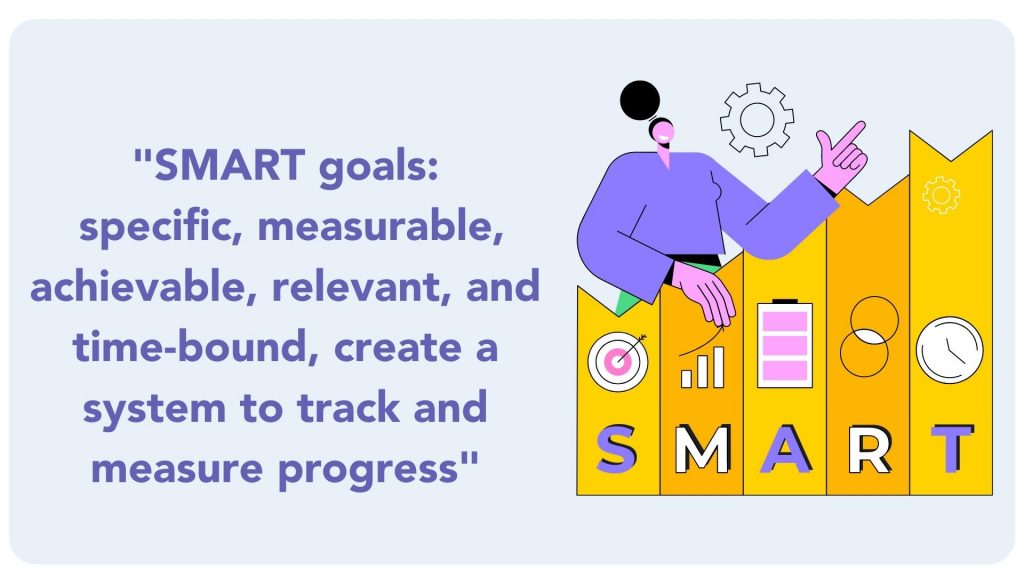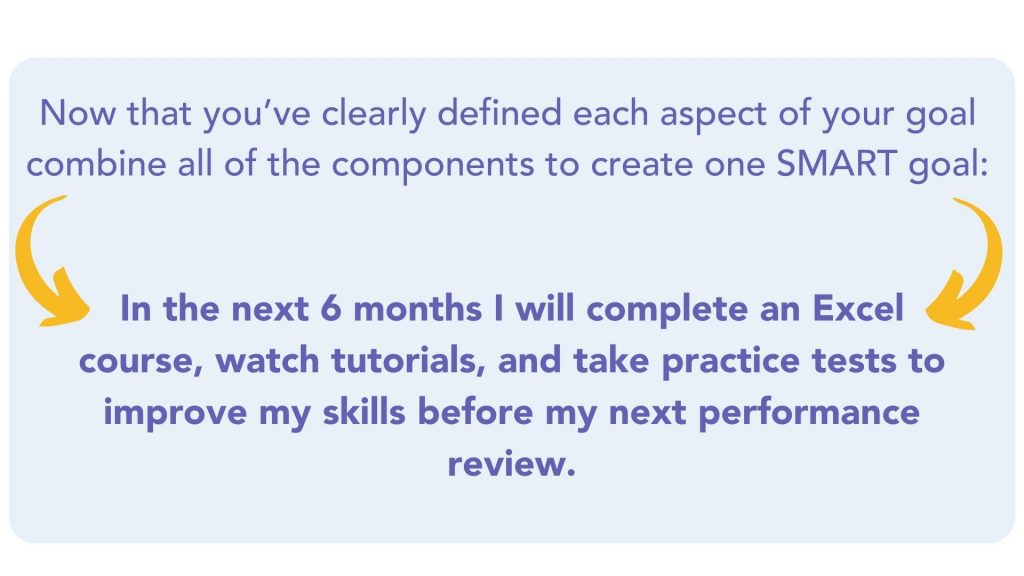Taking a thoughtful and measured approach to performance review goals for employees increases your businesses potential for success while benefiting your employees growth and engagement. In fact, research shows performance feedback increases company profitability and employee productivity as well as decreases employee turnover.
By implementing performance review SMART goals, managers are able to deliver actionable feedback to their direct reports and provide employees with a framework to understand how they contribute to the overall success of the business.
Here we’ll share 18 examples managers can use to implement performance review SMART goals to guide their teams.
What are SMART Goals and Why are They Important?
SMART goals, meaning specific, measurable, achievable, relevant, and time-bound, create a system to track and measure progress, which helps promote employee and organizational success. Performance review SMART goals provide employees with an understanding of the goal, its purpose, the way success will be measured, and the goal’s connection to broader company priorities.

Guide to Structuring Performance Review SMART Goals
Here is a general example of an initial goal we’ll use to walk you through the process of creating performance review SMART goals for employees:
I want to improve my performance.
This is a typical approach to a performance goal for employees however it is vague and hard to measure. The goal, as it stands, is likely unattainable, lacks specificity, and has no clear timeline, making it difficult to measure or achieve. With the right performance review questions, you can gain a deeper understanding of your employee’s goals and motivators, which will provide the information necessary to craft a SMART goal.
Now, let’s use the SMART goal framework to clarify and improve the goal.
Specific
Performance goals for employees should have clearly defined output expectations.
To help keep your goal specific, try answering these questions:
- What do I want to accomplish?
- Why is this goal important?
- Who is involved?
- Which resources or limits are involved?
Example: I want to improve my Excel skills because my role requires me to use Excel regularly.
Measurable
The performance goal should include specific criteria that measure the progress toward the goal.
A measurable goal should answer these questions:
- How much?
- How many?
- How will I know when it is accomplished?
- How do I measure progress?
Example: By the time of my next performance review, I should be able to create spreadsheets using complex formulas within a couple of hours. I should also be able to easily and effectively communicate how to create spreadsheets in a way my colleagues can understand and learn from.
Achievable
The outcome of a performance goal should be under the employees’ control, meaning external factors should not play a role in whether a goal is considered successfully achieved or not.
If you can answer these questions, you have an achievable goal:
- Do I have the resources and capabilities to achieve the goal?
- If not, what am I missing?
- Have others done it successfully before?
Example: I can dedicate 2 hours a week to take an Excel course, and one hour a week to watching tutorials to learn new skills.

Relevant
The performance goal should be relevant to the employees’ job responsibilities, lead to their professional development, and be relevant to the short- or long-term goals of the organization.
To determine if your goal is relevant, answer these questions:
- Why am I setting this goal now?
- Is it aligned with the overall business objectives?
Example: Working with Excel is 30% of my job responsibilities. As I progress at the company, I’ll be required to spend 50% of my time creating spreadsheets in Excel. My ability to proficiently use Excel will allow me to progress in my career.
Time-bound
The performance goal should have a clearly defined timeline, including a starting date and a target date.
Answer these questions to ensure you have a time-bound goal:
- Does my goal have a deadline?
- What should be achieved half-way through the process?
Example: In 6 months, I will complete a course and be proficient in Excel. I will be able to create a spreadsheet using complex formulas within a couple of hours, instead of the 4 hours it currently takes me.

18 Role-Specific Examples of Performance Review SMART Goals
For HR Teams
Employee engagement is an ever-present topic for HR teams. Here are 3 examples of SMART goals for improving employee engagement:
- Starting next quarter, we will host a monthly catered lunch for employees on the first Wednesday of the month to promote a sense of community within the organization.
- Create a mentorship program for new employees to join upon hire by next quarter.
- Craft a benefits awareness campaign to educate employees on how to maximize their benefits, and present at the next company all-hands meeting.
For Marketing Teams
Marketing teams are constantly working to reach a wider audience. Here are 3 examples of SMART goals for increased brand awareness:
- Improve organic reach to build brand awareness by converting our top 5 blog posts into video content by the end of the year.
- Secure 2 guest posts in relevant publications by the end of Q2 by reaching out to 5 publications a week with content ideas.
- Increase brand mentions by planning and hosting a contest on social media to align with our next product launch.
For Product Teams
Product teams often rely on customer feedback to improve the design and functionality of products. Here are 3 examples of SMART goals to improve customer feedback:
- Organize a quarterly meeting to discuss product roadmap and create a feedback form by Q3 for users to share feedback on product features.
- Hold a strategy meeting with sales to determine key questions to ask during sales calls to increase customer insight and implement by next month.
- Implement a feedback form onto the company website by the end of next week, and download responses to review during weekly check in.
For Engineering Teams
Engineering teams help ensure the product or service of a company is running smoothly and efficiently. Here are 3 examples of SMART goals to improve UX:
- Repair top 10 software bugs by the end of this quarter and run test programs after each partial completion to ensure success.
- Schedule regular weekly site audits to scan for glitches and bugs.
- Conduct 3 rounds of A/B testing before the next campaign launch to determine preferred user interface.
For Finance Teams
Having visibility and data over company spend is a key factor in maintaining a healthy company financial standing. Here are 3 examples of SMART goals for finance teams to improve spend management:
- Implement a payment tracking system for the company and all employees by Q2 and host training sessions in the first 2 weeks of implementation. Run weekly, monthly, and quarterly reports to influence strategic decisions.
- Run an expense audit at EOY and work collaboratively with HR to create an employee spend policy to implement at the end of Q1.
- By year end, cut company overhead cost by 5% by automating administrative tasks to reduce entry level support staff.
For Sales Teams
Sales teams rely on informative collateral to effectively communicate the value of a product to their audience. Here are 3 examples of SMART goals to improve sales rates:
- Increase win rate by 8% by the end of the year by working with the content team to produce short product focused videos that address customer pain points.
- Improve MQL captures by implementing a lead form on the company website.
- Implement a referral program and market it to your top 10% of customers in Q2.
Improve Your Performance Reviews With Omni
Performance review SMART goals are an effective tool to drive business success. However, they can be extremely time consuming for HR and managers to compile performance review forms and follow up with employees for submission.
With Omni’s customizable performance review feature managers can design a SMART goal template to apply to employee performance reviews, track employee submissions, and derive critical insights to drive business decisions all in one centralized platform.
To join the 83% of Omni customers who have unlocked new, actionable insights after using our performance management module, book a free demo with our team today.


